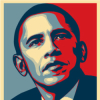Shepard Fairey

Shepard Fairey
Frank Shepard Faireyis an American contemporary street artist, graphic designer, activist, illustrator and founder of OBEY Clothing who emerged from the skateboarding scene. He first became known for his "Andre the Giant Has a Posse"sticker campaign while attending the Rhode Island School of Design, which appropriated images from the comedic supermarket tabloid Weekly World News...
NationalityAmerican
ProfessionGraphic Designer
Date of Birth15 February 1970
CityCharleston, SC
CountryUnited States of America